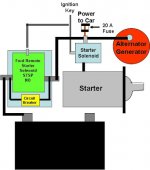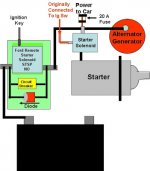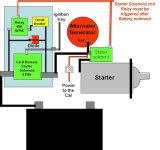RAC68
Darth Vader
Offline
Hi Andy and thanks for insights and suggestions.
After I had posted my last, I noticed the condition you mentioned and sent off an e-mail to the friends who had helped me select the connector. What I also noticed was that In the middle of a contactor switch from NC to NO, a full disconnect of power to the car could take place. This could result in a fall back of the contactor to the NC position and, if the key was still actuated, a repeat of the cycle until the key was released. The car may never start because the NO switch may never take place. Something could be added to the contactor to avert this issue or maybe there is something already in the contactor to address it or maybe it switches fast enough for this not to happen in the first place….something to look into.
Steve also mentioned the Ford solenoid and I came back to the Forum to update my last entry to ask him about it as I would like to find a less expensive alternative to the connector referenced.
I need to consider your other comments as they would also require some changes to the initial presentation. Yes, this is getting complicated but would like to follow this approach to a reasonable conclusion and would appreciate your continued help.
All the best,
Ray
After I had posted my last, I noticed the condition you mentioned and sent off an e-mail to the friends who had helped me select the connector. What I also noticed was that In the middle of a contactor switch from NC to NO, a full disconnect of power to the car could take place. This could result in a fall back of the contactor to the NC position and, if the key was still actuated, a repeat of the cycle until the key was released. The car may never start because the NO switch may never take place. Something could be added to the contactor to avert this issue or maybe there is something already in the contactor to address it or maybe it switches fast enough for this not to happen in the first place….something to look into.
Steve also mentioned the Ford solenoid and I came back to the Forum to update my last entry to ask him about it as I would like to find a less expensive alternative to the connector referenced.
I need to consider your other comments as they would also require some changes to the initial presentation. Yes, this is getting complicated but would like to follow this approach to a reasonable conclusion and would appreciate your continued help.
All the best,
Ray
Last edited:

 Hi Guest!
Hi Guest!

 smilie in place of the real @
smilie in place of the real @
 Pretty Please - add it to our Events forum(s) and add to the calendar! >>
Pretty Please - add it to our Events forum(s) and add to the calendar! >> 




